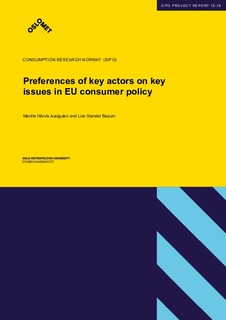| dc.contributor.author | Austgulen, Marthe Hårvik | |
| dc.contributor.author | Bøyum, Live Standal | |
| dc.date.accessioned | 2020-02-19T14:07:20Z | |
| dc.date.accessioned | 2021-04-29T12:45:24Z | |
| dc.date.available | 2020-02-19T14:07:20Z | |
| dc.date.available | 2021-04-29T12:45:24Z | |
| dc.date.issued | 2019 | |
| dc.identifier.uri | https://hdl.handle.net/20.500.12199/2986 | |
| dc.description.abstract | The aim of this report is to investigate what characterises the perceptions of and
preferences in EU consumer policy of various actor types that are involved in shaping
and implementing this policy. More specifically, we seek to identify and map the key
actor’s preferences as well as to investigate whether there is a structure in the
preferences of various actor types across issues and whether country differences in
actor preferences can be identified. Answers to these questions can contribute to
mapping the structures of the political space of consumer policy in the European Union.
The actor types investigated are government actors, consumer organisations and
business associations.
The preferences are measured through an open public consultation conducted by the
European Commission as part of the recent fitness check of EU consumer and
marketing law. The questions in the open public consultation broadly covered four key
issues: 1) The understanding of whether certain issues related to EU consumer and
marketing law that are problematic for the protection of the rights of consumers; 2)
Satisfaction with the impacts of EU consumer and marketing law; 3) Perceived
effectiveness of regulatory tools; and 4) Perception of suggested solutions for future EU
consumer policy.
The results show that there are significant differences between the types of actors on
several key issues. The main differences were found between the two types of interest
organisations, and a clear trend in the results is that the consumer organisations tend to
play up the importance of measures aimed at protecting consumers while the business
associations seek to tone down these issues and rather focus on reducing (third-party
initiated) regulation. Another interesting finding is that the preferences of the
government actors for the most part is closer to the preferences of the consumer
organisations than the business associations. Finally, the results show that the structure
in the actor preferences varies between the countries investigated. In some countries
the preferences of the government actor(s) closely follow the consumer organisations, in
some they follow the preferences of the business associations and in some countries
any such pattern cannot be identified. | en |
| dc.language.iso | en | en |
| dc.publisher | Consumption Research Norway (SIFO), OsloMet | en |
| dc.relation.ispartofseries | Report;15-2019 | |
| dc.subject | consumer policy | en |
| dc.subject | interest groups | en |
| dc.subject | consumer organizations | en |
| dc.subject | business associations | en |
| dc.subject | European Union | en |
| dc.title | Preferences of key actors on key issues in EU consumer policy | en |
| dc.type | Research report | en |
| fagarkivet.source.pagenumber | 41 | en |
